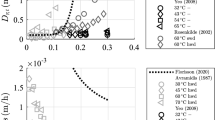Abstract
This paper presents a qualitative explanation of the creep phenomenon based on the physical and chemical mechanisms that occur at micro and ultra-structural levels of wood during moisture diffusion. This part is then completed by the formulation of a 3-dimensional non linear hydro-visco-elastic model, combined with hygro-expansion effects, and able to describe creep and recovery phenomena under variable humidity conditions. The constitutive relation is based on a generalised Maxwell model whose relaxation time functions depend on the moisture content rate, the history of accumulated moisture variations and the stress level. The model was implemented in a Finite Element (FE) program. Several applications based on external experimental tests and with creep periods ranging from 1 to 2735 days were carried out in order to prove the relevance of the approach at different structure scales. A local strain energy density criterion, associated with a flow law, allows the representation of the rupture phase initiated by the tertiary creep and is incorporated into the model in order to open up new horizons for the service life estimation of timber structures.
Similar content being viewed by others
References
Alfthan, J., ‘Micro-mechanically based modelling of mechano-sorptive creep in paper’, PhD Thesis, KTH Solid Mechanics Royal Institue of Technology, Stockholm, Sweden, 2004.
Avramidis, S., ‘Evaluation of three-variable models for the prediction of equilibrium moisture content in wood’, Wood Sci. Technol. 23, 1989, 251–258.
Bach, L., ‘Reiner-Weissenberg's Theory applied to time-dependent fracture of wood subjected to various modes of mechanical loading’, Wood Sci. Technol. 5, 1973, 161–171.
Bažant, Z.P. and Wu, S.T., ‘Rate type creep law of aging concrete based on Maxwell chain’, Materials and Structures 7, 1974, 45–60.
Bažant, Z.P., ‘Constitutive equation of wood at variable humidity and temperature’, Wood Sci. Technol. 19, 1985, 159–177 .
Bažant, Z.P. and Chern, J.C., ‘Strain softening with creep and exponential algorithm’, Journal of Engineering Mechanics 111(3), 1985, ASCE.
Bengtsson, C., ‘Mechanosorptive creep of wood in tension and compression’, 1st RILEM Symposium on Timber Engineering, Stockholm, 13–15 September, 1999, pp. 317–326.
Boyd, J.D., ‘An anatomical explanation for visco-elastic and mechanosorptive creep in wood, and effects of loading rate on strength’, New Perspectives in wood Anatomy, P. Baas (Ed.), 1982, 171–222.
Dinwoodie, J.M., Timber, its nature and behavior, Van Nostrand Reinhold New York, 1981.
Fridley, K.J., Tang, R.C., Soltis, L.A. and Yoo, C.H., ‘Hygrothermal effects on load-duration behaviour of structural lumber’, Journal of Structural Engineering 118, 1992, 1023–1038.
Habeger, C.C. and Coffin, D.W., ‘The role of stress concentrations in accelerated creep and sorption-induced physical aging’, Journal of Pulp and Paper Science 26(4), 2000, 145–157.
Hanhijärvi, A., ‘Modelling of creep deformation mechanisms in wood’, Technical Research Centre of Finland Espoo, Finland, VTT Publications 231, 1995.
Hanhijärvi, A., ‘Advances in the knowledge of the influence of moisture changes on the long term mechanical performance of timber structures’, Materials and structures 33, 2000, 43–49.
Haslach, Jr H.W., ‘A model for drying-induced microcompressions in paper: Buckling in the interfiber bonds’, Composites Part B 27B, 1996, 25–33.
Haslach, Jr. H.W., ‘The moisture and rate dependent mechanical properties of paper: A review’, Mechanics of Time Dependent Materials 4, 2000, 169–210.
Houška, M., Bučar, B., ‘Mechanosorptive behaviour of different categories of sprucewood’, Proceedings of the 1st International Conference on Mechanics of Time Dependent Materials, Society for experimental mechanics, Bethel, 1995, 173–178.
Houška, M. and Koc, P., ‘Sorptive Stress Estimation: An Important Key to the Mechanosorptive Effect in Wood’, Mechanics of Time-Dependent Materials 4, 2000, 81–98.
Lasserre, B., ‘Long-term modelling of timber structure coupled to moisture and heat properties’, PhD Thesis, Bordeaux I University, France 2000.
Leicester, R.H., ‘A rheological model for mechano-sorptive deflections of beams’, Wood Sci. Technol. 5, 1971, 211–220.
Liu, J.Y. and Schaffer, E.L., ‘Energy Criterion for load duration problem in wood’, 10th Engineering Mechanics Conference, Boulder, New York ed. Stein Sture, ASCE, 2, 1995, pp. 1321–1327.
Navi, P., Rastigi, P.K., Pittet, V. and Tolou, A., ‘Micromechanics of wood subjected to axial tension’, Wood Sci. Technol. 29, 1995, 411–429.
Pittet, V., ‘Experimental study of mechanosorptive coupling in wood subjected to controlled moisture variations under long term loading’, PhD Thesis, Swiss Federal Institute of Technology, Lausanne 1996.
Ranta-Maunus, A., ‘The viscoelastisity of wood at varying moisture content’, Wood Sci. Technol. 9, 1975, 189–205.
Ranta-Maunus, A., ‘Creep of timber during eight years in natural environments’, Proceeding of the World Conference on Timber Engineering, British Columbia, July–August 2000.
Reiner, M., ‘A thermodynamic theory of strength’, Rosen, B., ed., Fracture Process in Polymeric Solids-Phenomena and Theory, Wiley-Interscience, New York 1964.
Skaar, C., ‘Wood-Water Relations’, Springer-Verlag, New York 1988.
Toratti, T., ‘Creep of timber beams in a variable environment’, PhD Thesis, Helsinky University of Technology, Finland 1992.
Yahiaoui, K., ‘A rheological model to account for mechano-sorptive behavior’, in Martensson A., Ranta-Maunus, A. and Seoane, I. (eds), Presentations at the COST 508 Wood mechanics Workshop on Fundamental Aspects of Creep in Wood, Lund, Sweden, 20–21 March (Commission of the European Communities), 1991, pp. 27–35.
Author information
Authors and Affiliations
Rights and permissions
About this article
Cite this article
Chassagne, P., Saïd, E.B., Jullien, J.F. et al. Three Dimensional Creep Model for Wood Under Variable Humidity-Numerical Analyses at Different Material Scales. Mech Time-Depend Mater 9, 1–21 (2005). https://doi.org/10.1007/s11043-005-9001-y
Received:
Accepted:
Published:
Issue Date:
DOI: https://doi.org/10.1007/s11043-005-9001-y




